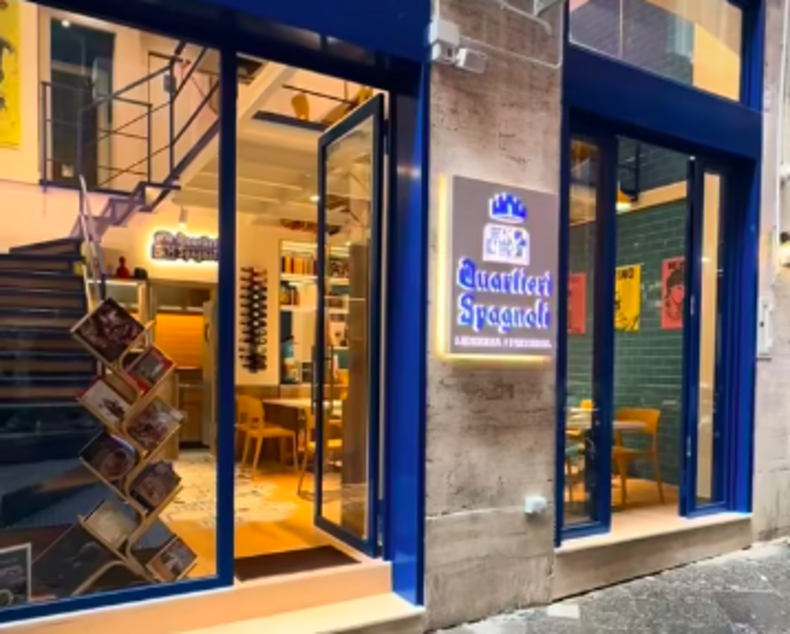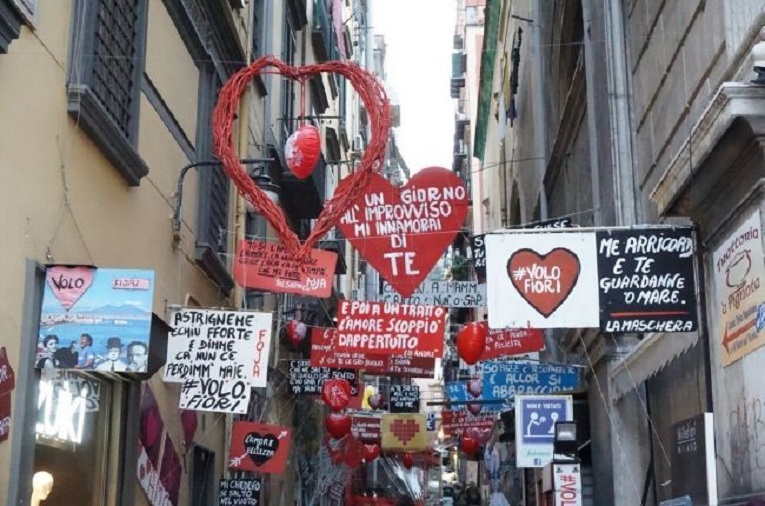
Is it your first time in Naples and you don’t know what to visit in 7 days? No problem, I’m here to give you some advices about 10 places you can’t lose in the biggest city of Southern Italy. It must be said, first of all, that Naples is connected by two subway lines and 4 funiculars connect to the higher areas. The meeting point of metro lines is the Garibaldi stop, which is also home to the central station. A tip can be to take line 1, get off at the splendid Toledo stop, or the Municipio one, and then simply walk, letting yourself be inebriated by the unique Neapolitan atmosphere.
1. Historic Center
Mergellina’s seafront is one of the most beautiful streets in Italy. It is a 3 km path whitch runs above Naples’ Gulf. It links the port area to Posillipo neighborhood. Along this walk, and more precisely in Piazza Municipio, it will be possible to visit Castel Nuovo, a medieval stronghold dating back to the thirteenth century built by King Charles I of Anjou.
Carrying on it will be possible to get to Castel dell’Ovo, it is the oldest castle in the city of Naples, built up in Roman era. It is setteled on the Megaride Island, and it can be reached and visited via a bridge whitch connects the mainland to Borgo Marinari.
Further on you will reach the Villa Comunale, the main green lung of the Chiaia district and the so-called “Lido Mappatella” beach. This is probably the favorite destination for joggers. The route ends in Mergellina, a place famous for its fishing port and its famous chalets. Along the entire route it will be possible to see Vesuvius, the Sorrento coast and the island of Capri. The seafront of Mergellina inspired Giovanni Capurro to compose the famous neapolitan song “‘O Sole mio” (My Sun). Naples looks to west, facing the direction of the sun. This is why Naples is known as “‘O paese d’o Sole” (The village of the sun).
2. Piazza Plebiscito
Piazza Plebiscito is the biggest square in Naples and one of the biggest in Italy. It is located between the Seafront and Toledo Street. The high part of the square is surrounded by the columns of Basilica di San Francesco di Paola, a church considered one of the most important examples of neoclassical architecture in Italy. In front of the church there are the two imposing equestrian statues of Charles III of Bourbon and Ferdinand I of the Two Sicilies. On the square’s botton there’s the Naples Royal Palace, residence of the Spanish and then Austrian viceroys, and afterwards of the Bourbon dynasty until 1815. In the main entrance’s wall it’s possible to see the statues of the main Naples’ kings. The palace is linked to San Carlo Theater, which was founded in 1737, and it is the oldest opera house in the world still active.
3. Via Toledo
Via Toledo is the it is the main commercial street of the city. During his stay in Naples, Herman Melville said that for the crowd of people passing through via Toledo, it would have been impossible to distinguish it from Brodway. Via Toledo connects Piazza Plebiscito to the historic center of Naples and runs alongside the Quartieri Spagnoli. Along via Toledo, in addition to clothing shops and kiosks of the famous Neapolitan street food, there is one of the entrances to the imposing Galleria Umberto I. Via Toledo is mentioned in the well-known Neapolitan song by Renato Carosone “Tu vuò fa l’americano“.
*Quartieri Spagnoli
The Quartieri Spagnoli are the most famous popular area of the city. It is the real beating heart of the town. It is a network of alleys so narrow that it is almost impossible to see the sun. This attribute inspired the popular ballad “La città di Pulcinella“, referring to Pulcinella, the Carnival Mask which represents the city. The Quartieri Spagnoli are full of spritz bars and typical trattorias, such as the famous Cammarota Spritz and Trattoria Nennella. This area is characterized by a frenetic nightlife. Quartieri Spagnoli is also well known for its spectacular streetart, which represents characters who have written the history of the city, such as the actors Totò and Massimo Troisi, the singer-songwriter Pino Daniele, and of course the footballer Diego Armando Maradona.
In one of the highest part of the neighborhood there’s the Diego Maradona Mural. It is painted on the wall of a high building and, with the blue Napoli t-shirt and with the captain’s armband, it seems to lead the entire city to the victory. After Diego’s death, the greatest footballer in history, the “Largo Maradona” has become a place of pilgrimage and worship for tourists and football fans.
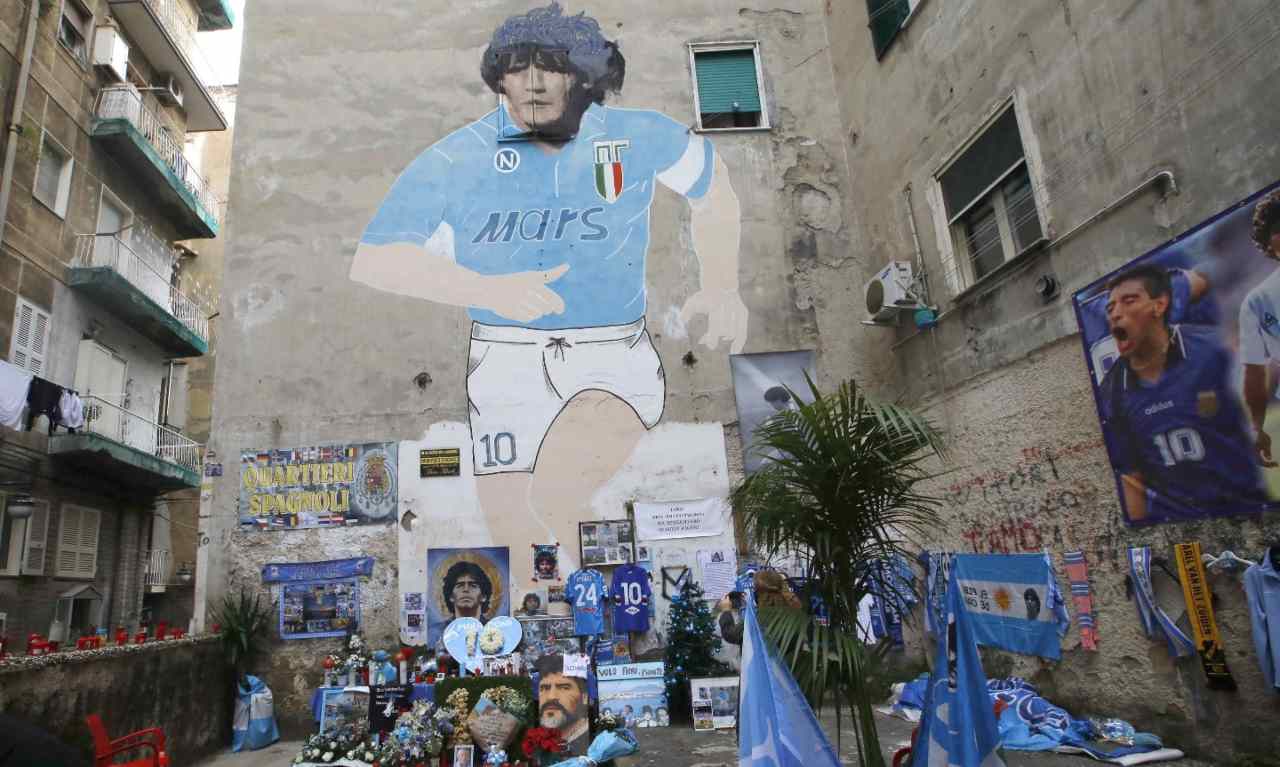
4. Centro Storico
The historic center of Naples contains three millennia of history and it is one of the largest in Europe. Its monuments testify to the succession of cultures of the Mediterranean. a portion of the historic center was declared a UNESCO World Heritage Site in 1995. A good starting point can be Piazza Dante, a big square which has a statue of Dante Alighieri in the middle. The square is located in the top of via Toledo, but it’s easily reachable also through the Dante stop of Line 1.
A place of interest is the Duomo di San Gennaro, bishop and Christian martyr, as well as patron and protector of the city. The cathedral is known for its pictorial riches and for the San Gennaro’s Chapel of the Treasure. Every September 19, the faithful witness the miracle: the saint’s blood, contained in a glass vial, liquefies in response to prayers. This is considered a good omen.
*Spaccanapoli
In the middle of the city opens up via Spaccanapoli, a straight line of more than one kilometer, narrow and vociferous, which divides the huge agglomeration in two. “Spaccare” means litteraly “to split”. Along the road, which runs alongside Piazza Dante, you can find places of interest.
The church of Santa Chiara, located in piazza del Gesù Nuovo. It is famous for its immense rose window, the baroque bell tower dating back to 1300 and the wonderful cloister.
Further on you will reach piazza San Domenico Maggiore, near which you can visit the Chapel of San Severo, a deconsecrated church, now a museum. The chapel of San Severo houses the wonderful marble sculpture of the Veiled Christ by Giuseppe Sanmartino, a representation of the body of Jesus covered by the veil after the crucifixion.
*Via dei Tribunali
Via dei Tribunali is parallel to Spaccanapoli. This street connects Piazza Bellini, a site known for its nightlife to the Forcella district. Via dei Tribunali is a lively street, famous for its renowned pizzerias. Along this road you will reach the portico of the Palazzo D’Angiò, the Girolamini church. The road intersects with Via San Gregorio Armeno, a road known for the sale of handmade cribs. Still along this street there’s Piazza San Gaetano, which marks the entrance to one of the underground sites of Naples.
As previously mentioned, the road ends in the Forcella district, exactly at Castel Capuano. Forcella is mainly known for Antica Pizzeria da Michele, which prepares the most traditional margherita pizza in the city. The marble statue of The Resting Hercules is perhaps second in beauty only to the mosaic depicting Alexander the Great riding Bucephalus.
*Piazza Cavour: National Archaeological Museum
Not far from the aforementioned Piazza Bellini there’s the National Archaeological Museum, more correctly in Piazza Cavour. It is considered one of the most important Greek and Roman art museums in the world. The marble statue of “The Resting Hercules” is perhaps second in beauty only to the mosaic depicting Alexander the Great riding his Bucephalus.
5. Rione Sanità
Behind Piazza Cavour there’s the entrance of Rione Sanità. Just like the Quartieri Spagnoli and the Historic Center, the Rione Sanità is also a popular area. This is the district where the actor and poet Totò lived. The district is famous for the Spanish Palace in Via Vergini. It is the finest example of the Neapolitan Baroque style, thanks, mainly, to the double flight staircase which constitutes the internal building’s facade.
Just out of it it’s possible to see in mid-air the lyrics of the Pino Daniele song “Napule è“, a real masterpiece that the singer-songwriter dedicated to his hometown.
A fascinating and mysterious place is the Cimitero delle Fontanelle is an ancient cemetery in the city of Naples, located in via Fontanelle. the cemetery houses about 40,000 remains of people, victims of the great plague of 1656 and of the cholera of 1836. The cemetery is located in tuffaceous quarries for about 3000 cubic meters in depth. The cemetery is also known because a particular rite took place there, which involved the adoption and arrangement of a skull in exchange for protection.
Naples in 7 days: the Castle and more
6. Castel Sant’Elmo
Through the funiculars of Montesanto, Toledo and Chiaia, but also to Metro Line 1, at the Vanvitelli stop, it is possible to reach the Vomero district. This is a fancy area with many fashion stores and pubs, in which is really pleasant to walk. The highest part is worthy of interest, where is located the Catel Sant’Elmo, easily accessible also thanks to an escalator system. The castle dates back to the 14th century and overlooks the entire city. Next to the stronghold there is the Certosa di San Martino, a monastery which is often used as an art gallery. The view from this point is wonderful.
Naples is connected: from here, through the steps of the petraio it will be possible to return quickly to the Quartieri Spagnoli.
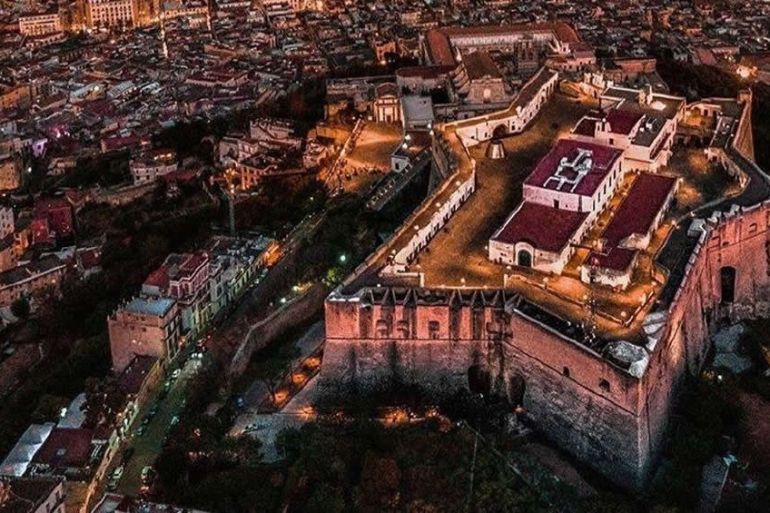
7. Bosco di Capodimonte
Starting from the National Museum, and taking a bus (178, 185 or C67 are ok), you can easly get to the “Capodimonte Wood“, a beautiful and immense park, in front of the homonymous palace. The Capodimonte park covers an area of one hundred and twenty-four hectares. Here you can spend pleasant days outdoors the main one is the Porta di Mezzo, a wrought iron gate, considered one of the most elegant examples of Neapolitan Rococo works. The Reggia di Capodimonte is in the park. It’s a Baroque-style palace, the historic residence of the Bourbons in Naples. Today it is a museum visitable for the beauty of its Bourbon and French halls, the porcelain parlor of Maria Amalia of Saxony. The palace stands next to the belvedere. from here the view over the city of Naples is magnificent.
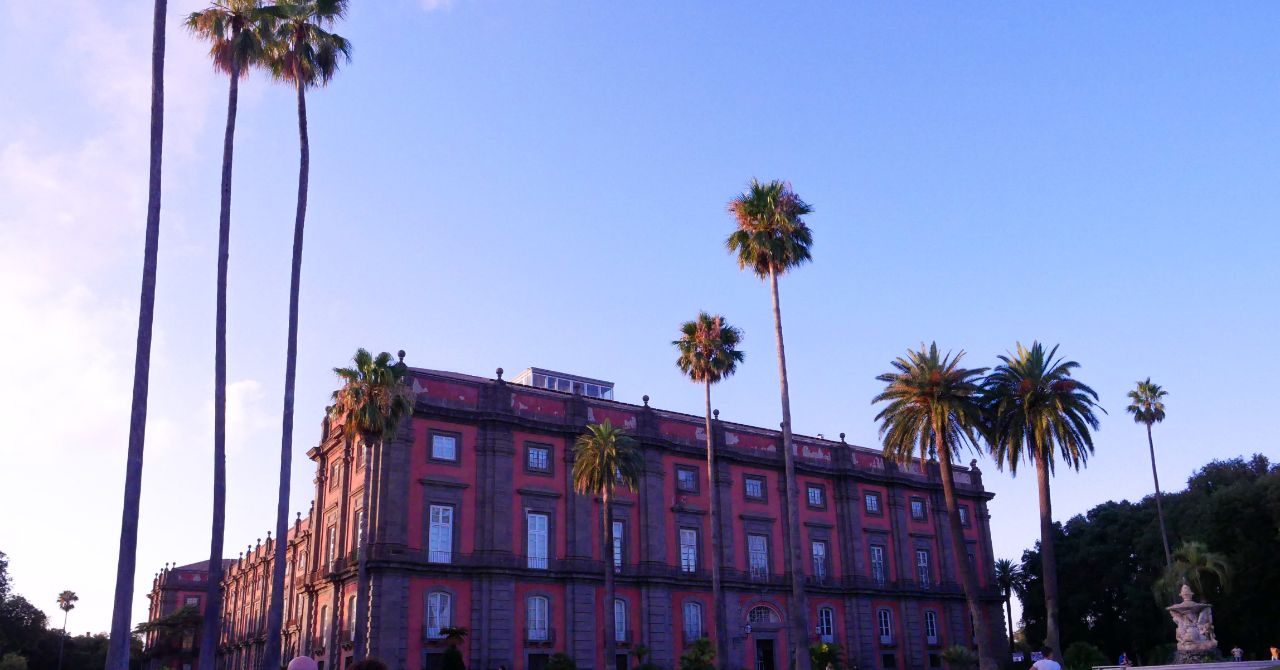
8. Posillipo
Another area not to be missed is that of Posillipo. This is the hill north of the city. All the most famous panoramic photographs of Naples were taken here, and more precisely from the Terrazza di Posillipo, at the top of the so-called 13 Descents of Sant’Antonio. From this point, the panoramic view, especially at sunset, allows for romantic and highly effective photos. The view is indescribable, it takes your breath away. You can clearly see Vesuvius and Mount Somma, the Sorrento peninsula, as well as the entire waterfront with the Castel dell’Ovo in the center and the Vomero hill. Getting there without a car is a bit tiring: the fastest way is to take the 13 descents that separate the uphill terrace from the terrace, starting from Piazza Sannazzaro, in the Mergellina area.
Honestly the posillipo hill is rich in scenic beauty. Via posillipo is a long and narrow road that connects Mergellina to the top, and is entirely covered by bus 140. Palazzo Donn’Anna is a monumental building on the sea, whose peculiarity is that it is unfinished. Noteworthy is the small bay at the foot of the splendid villa volpicelli, recognizable by the high cylindrical tower. Here it is very pleasant to sit on the wall of rocks and observe the sea, especially at dawn.
*Marechiaro
Once you have reached the highest part of via Posillipo it will be possible to walk down to the Marechiaro cliff, or to go up to the Virgiliano Park. Marechiaro is an ancient village located at the end of the homonymous descent on a large rock overlooking the sea. The marechiaro area has always been one of the symbols of the Italian dolce vita, with its typical restaurants overlooking the gulf. It is also the object of a bathing tour for its clear waters that touch the rocks.
*Parco Virgiliano
It is a panoramic park located on the promontory of the posillipo hill. The park is characterized by a system of terraces overlooking the Gulf of Naples, from which you can see the islands of Procida, Ischia and Capri, the islet of Nisida, the Gulf of Pozzuoli, the districts of Agnano, Fuorigrotta , Rione Traiano, Pianura, the Camaldoli Hermitage, the Gulf of Bacoli and the promontory of Capo Miseno, Monte di Procida, Vesuvius, the Vesuvian coast, the Sorrento Peninsula.
*Submerged Park of Gaiola
It is a protected marine area of 42 hectares of sea that surrounds the Gaiola Islands in the Gulf of Naples and which extends from the Borgo di Marechiaro to the Bay of Trentaremi, jointly established by the Ministries of the Environment and Cultural Heritage in 2002. Its peculiarity is due to the fusion of volcanological, archaeological and biological elements. On the backdrops of the Park it is possible to observe the remains of ports currently submerged due to bradyseism. The Imperial Villa of Pausilypon is part of the park, flanked by the remains of the imposing theater of the 1st century BC, now part of the Archaeological Park of Posillipo.
9. Underground Naples sites
We’re talking about the most fascinating and suggestive part of the city. The subsoil of Naples is crossed by a large network of tunnels, tunnels, aqueducts and spaces excavated and used by man during the history of the city since several centuries before Christ, which can still be visited today. The underground sites are distinguished from underground archaeological finds for their underground origin since their construction. Among the most fascinating sites are the tunnels and the Greco-Roman aqueduct (in Piazza San Gaetano, referred to in the paragraph concerning the historic center) and the Bourbon Gallery (Acces in Via Domenico Morelli).
*Greco-Roman aqueduct
It is is an underground aqueduct, built starting from the 4th century BC. The Romans used the tuff quarries for an extensive system of underground aqueducts. There are the remains of a 1st-2nd century Greco-Roman theater with a capacity of 6,000 people where Nero is said to have sung during an earthquake.
*Tunnel Borbonico
The Bourbon Tunnel is an underground cavity in Naples that extends along the Pizzofalcone hill, near the Royal Palace, in the San Ferdinando district. It is one of the best known and most visited routes in Underground Naples. It is a fascinating journey. It is a real tour inside the cavities and cisterns of Naples “below“. Along the way, you will pass through the rooms linked to the Renaissance sections of the Bolla aqueduct and those adapted to military shelters during the Second World War. Along the way, huge fragments of statues, vintage cars and motorbikes, found buried under waste and debris, linked to the period between the end of World War II and the 1970s, will form an incredible frame.
Naples in 7 days: football passion
10. Stadio Diego Armando Maradona
If we talk about Naples, we cannot fail to mention its football facility. If you have the opportunity, it is recommended to experience the Stadium. The Diego Armando Maradona stadium, formerly known as San Paolo, is without a doubt the hottest place in the city. It is located in the Fuorigrotta district and can be easily reached with Line 2, getting off at the Campi Flegrei stop. It has a capacity of 55,000 spectators. Naples is a city that lives in symbiosis with its team, being the only professional team in the municipality. Precisely for this reason the average fan does not belong to a specific class: Napoli confuses and compacts very different people, it is everyone’s team. The cheering reaches such peaks, that on some occasions the scream of the fans at the goal has been recorded as an earthquake by the seismographs of the Federico II University.
Bonus mention: Scampia
The Scampia district deserves to be mentioned. It is located in the northern area of the city, and borders the districts of Piscinola, Miano and Secondigliano. It is a popular suburb, famous mainly for “Le Vele”, as the emblem of one of the most degraded and problematic neighborhoods in the entire city of Naples. It is a residential complex that takes its name from the triangular shape, which resembles a sail. Such a density of people in precarious socio-economic conditions in such a large complex has led to the explosion of organized crime, which has found fertile ground for all its trafficking. The charm of the Sails is unique and today they are considered the symbol of the neighborhood’s rebirth.
The film Gomorrah by Matteo Garrone, and even more the homonymous TV series, awakened the civil conscience, both of the local administration and of the inhabitants of Scampia themselves, in search of a social redemption. Scampia’s transformation process is similar to that of Harlem or the Bronx. Scampia is a reborn neighborhood, full of sports fields, social activism and university centers.





